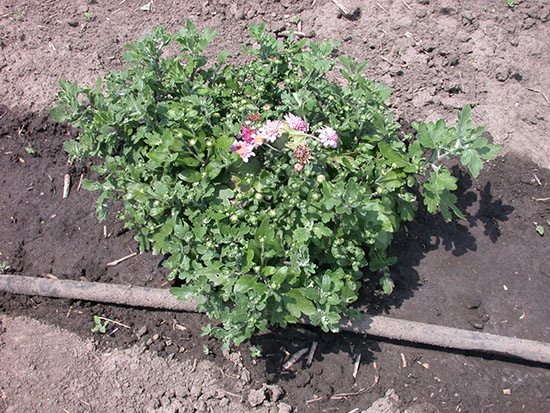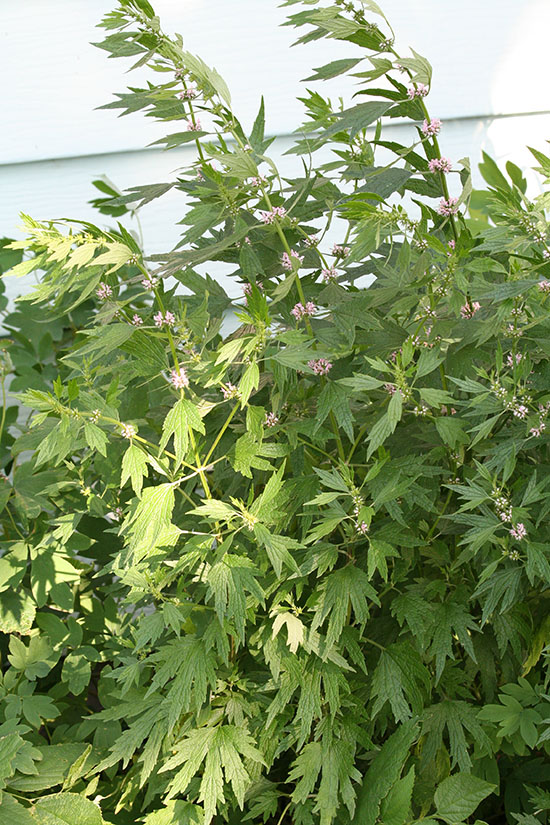Issue 11, July 28, 2014
Mugs, Mothers, and Mums
Occasionally, I am asked by gardeners or homeowners for identification of a "mum that is perhaps not a mum." Clients say it looks similar to a mum but it is growing rampantly. Without seeing the plant in person and without knowing the history of the site, it can be challenging to know for sure what the plant's proper identification is. There are a few different types of mums which adds to the confusion. Recently, the Plant Clinic was contacted by a gardener who had ordered and purchased mums but instead received something mum-like with huge rhizomes. Most likely what they received was mugwort.

A typical garden mum.
Mugwort (Artemisia vulgaris) is also known as chrysanthemum weed. It is a clump-forming perennial that spreads by rhizomes. The leaves are dark green and have a sage-like odor. The leaf shape is similar to that of garden chrysanthemums (mums). Leaves are lobed and alternately arranged on the stem. The degree of lobing can vary however. Generally, leaves on the mid to upper part of the plant are more deeply lobed and linear – pointier if you will. The major difference between the leaves of these two species is that mugwort leaves are white-woolly almost silvery on the underside. Mum leaves may be only somewhat hairy and will be the same color top and bottom. Additionally, mugwort flowers are nothing like that of mum and won't add that pop of fall color to your garden. Instead flowers are inconspicuous and form in leafy spike-like clusters at the end of stems. They appear from July to September. So, if you are uncertain about identification, letting it bloom will certainly give you the answer.
Mugwort stems are erect and branched. Propagation is typically by its long, stout rhizomes, and seedlings are rarely found. Mugwort is often found in waste areas and roadsides. It can be found in landscapes and nurseries. Many infestations are due to spread of contaminated soil and plant materials.

An illustration of Mugwort as found in "Common Weeds of the United States," USDA.
Controlling mugwort can be challenging as it tolerates mowing, cultivation and many herbicides. Repeated pulling or digging out can be helpful. Be sure to wear gloves as dermatitis has been reported by some. Plan on repeat applications of a non-selective herbicide. Keep sprays off of nearby desirable plants as plant injury or death can result. Studies have also shown that dicamba and clopyralid can be effective on mugwort.
Some fun facts and folklore provided by Ohio State University list mugwort as being used to flavor beer. Also it was believed to provide protection from sunstroke, fatigue, wild animals, and evil spirits. So perhaps having it in the garden wouldn't be such a bad thing. Ha!

Motherwort found growing by the backdoor of an old farmhouse.
Mugwort should not be confused (but can easily be) with motherwort, another herb that is somewhat similar in appearance and has its own folklore. This plant, Leonurus cardiaca, has a history of medicinal use for heart ailments. Additionally, it was used to remedy nervousness, dizziness and other disorders of women (an interesting addition to the garden I think). It can be found in waste areas, roadsides, old gardens, fields, and meadows. Like mugwort, it has an extensive root system. The leaves are lobed but oppositely arranged unlike the alternate leaves of mugwort. Motherwort flowers are small, pink to purple, and are grouped in clusters at the leaf axils. Individual flowers have a tube and 2 lips. They occur July through September. (Michelle Wiesbrook)
Author:
Michelle Wiesbrook